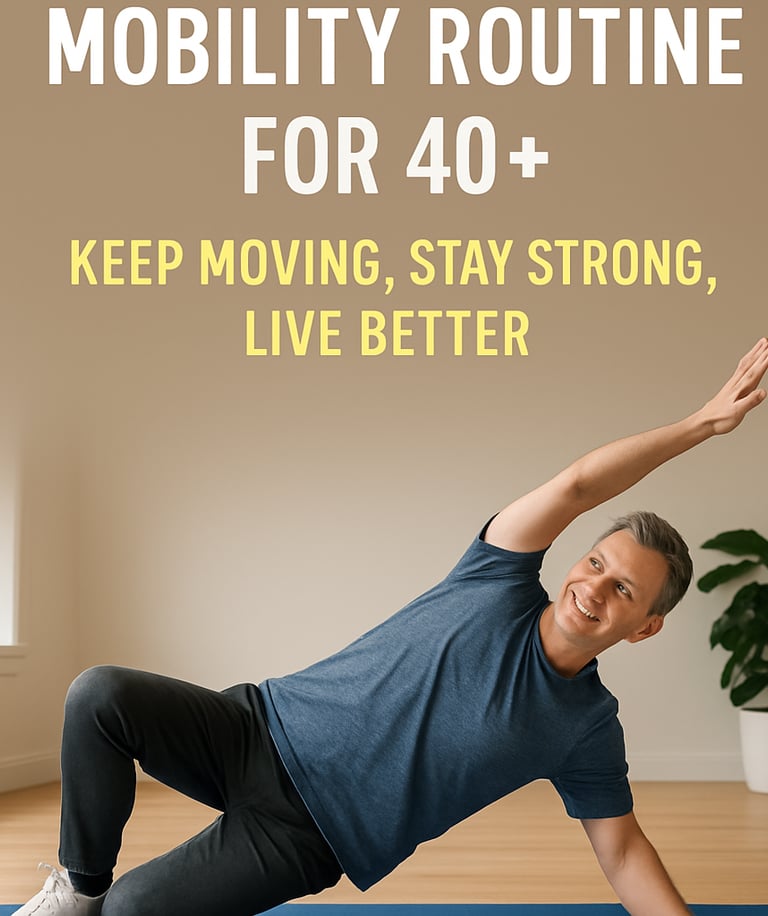The Ultimate Mobility Routine for 40+ — Move Freely, Stay Strong, Age Gracefully
Turning 40 often marks a new phase in life, where the body’s natural resilience begins to change. You may notice more stiffness, aches, or reduced ease in movements that once felt effortless. This isn’t inevitable—how you move matters profoundly. Incorporating a well-structured mobility routine can slow down many age-related declines and help you maintain strength, flexibility, and overall joint health.
MOBILITY
Ravisankar Lakshminarayanan
5/25/20254 min read


The Ultimate Mobility Routine for 40+ — Move Freely, Stay Strong, Age Gracefully
Introduction
Turning 40 often marks a new phase in life, where the body’s natural resilience begins to change. You may notice more stiffness, aches, or reduced ease in movements that once felt effortless. This isn’t inevitable—how you move matters profoundly. Incorporating a well-structured mobility routine can slow down many age-related declines and help you maintain strength, flexibility, and overall joint health.
Mobility differs from flexibility—it’s the ability of your joints to move through their full range of motion with control, combining strength, balance, and coordination. For people over 40, prioritizing mobility can prevent injuries, improve posture, and maintain independence.
Why Mobility Is Critical After 40
Biological Changes Affecting Movement
Joint Degeneration: Cartilage wears down over time, leading to stiffness and discomfort.
Muscle Mass Decline: Starting around age 30-40, adults lose 3-5% of muscle mass per decade if inactive.
Decreased Synovial Fluid: The natural lubrication in joints reduces, limiting smooth motion.
Connective Tissue Changes: Ligaments and tendons lose elasticity, reducing flexibility.
Postural Shifts: Sedentary lifestyles and desk jobs promote forward head, rounded shoulders, and spinal stiffness.
Neuromuscular Slowdown: Reaction times and coordination decline, increasing fall risk.
Benefits of a Regular Mobility Routine for Adults Over 40
Reduced Risk of Chronic Pain and Arthritis
Gentle joint movement stimulates cartilage health and synovial fluid production, helping prevent or ease osteoarthritis symptoms.Improved Balance and Fall Prevention
Mobility work enhances proprioception—the body's ability to sense position and movement—which declines with age.Enhanced Muscle Function and Strength
Full-range joint movement optimizes muscle activation patterns, preventing imbalances and weakness.Better Posture and Spinal Health
Mobility exercises target thoracic spine, hips, and shoulders to counteract effects of prolonged sitting and poor ergonomics.Increased Energy and Mental Clarity
Movement boosts blood flow and releases endorphins, improving mood and cognitive function.
Common Mobility Challenges After 40
| Challenge | Cause | Impact |
|--------------------------|-------------------------------|--------------------------------|
| Stiff hips | Prolonged sitting, tight muscles | Difficulty squatting, walking |
| Limited ankle flexibility| Lack of dynamic movement | Poor gait, balance issues |
| Rounded shoulders | Desk jobs, poor posture | Neck and shoulder pain |
| Lower back stiffness | Weak core, spinal degeneration | Chronic back pain, reduced bending |
| Reduced thoracic rotation| Sedentary lifestyle | Limited upper body mobility |
Key Components of a Mobility Routine
Warm-Up: Activate muscles and joints with dynamic movements.
Joint-by-Joint Focus: Work through ankles, knees, hips, spine, shoulders, and wrists.
Dynamic Movements: Controlled motion through full range without holding (for warm-up).
Static Holds & Stretching: Improve muscle length and joint capsule flexibility.
Breath & Alignment: Maintain good posture and breathe rhythmically to enhance neuromuscular connection.
Progressive Overload: Gradually increase movement intensity and duration.
Daily Mobility Routine for 40+ (20-25 minutes)
1. Warm-Up (3-5 Minutes)
Marching in Place or Light Cardio: Increase heart rate and blood flow.
Arm Circles: 10 forward and backward.
Hip Swings: Swing each leg forward and back, then side to side, 10 times each.
2. Ankle Mobility (3 minutes)
Ankle Circles: Sit or stand, rotate ankle 10 times each direction.
Ankle Dorsiflexion Stretch: Stand facing a wall, place toes near wall, lean forward keeping heel down, hold 30 seconds per side.
Heel and Toe Raises: 15 repetitions to activate calf and shin muscles.
3. Hip Mobility (5 minutes)
90/90 Hip Stretch: Sit with one leg bent in front and the other behind at 90°, lean forward and backward to open hips. Hold 30 seconds each side.
Hip Flexor Stretch: Kneel on one knee, push hips forward, hold 30 seconds per side.
Hip Circles: Standing hands on hips, circle hips 10 times each direction.
4. Thoracic Spine Mobility (3 minutes)
Cat-Cow Stretch: On all fours, arch back up (cat) and down (cow), 10 cycles.
Seated Spinal Twist: Sit tall, twist upper body gently side to side, hold 20 seconds per side.
Thread the Needle: On all fours, reach one arm under the body and twist open, 10 reps per side.
5. Shoulder and Upper Back Mobility (4 minutes)
Shoulder Rolls: Forward and backward, 10 reps each.
Chest Opener: Clasp hands behind back and lift chest gently, hold 30 seconds.
Wall Angels: Stand against wall, slide arms up and down like a snow angel, 10 reps.
6. Core Stability & Mobility (5 minutes)
Quadruped Reach (Bird Dog): On all fours, extend opposite arm and leg, hold 5 seconds, 10 reps per side.
Side Plank: Hold 15-20 seconds per side (modify with knees down if needed).
Pelvic Tilts: Lying on back, tilt pelvis to flatten low back, hold 5 seconds, 10 reps.
7. Cool Down and Stretch (3-5 minutes)
Child’s Pose: Hold 30 seconds, focus on deep breathing.
Hamstring Stretch: Seated or standing, reach toward toes, hold 30 seconds each leg.
Neck Stretch: Gently tilt head side to side, hold 20 seconds each.
Additional Tips for Success
Be Consistent: Mobility improves gradually with regular practice.
Listen to Your Body: Avoid sharp pain; mild stretch or tension is expected.
Hydrate and Nourish: Healthy cartilage and muscle tissue need good nutrition.
Integrate Strength Training: Strong muscles protect joints and support mobility.
Posture Awareness: Throughout the day, check your posture, take breaks from sitting.
Lifestyle Habits to Support Mobility
Take frequent breaks from sitting (every 30-45 minutes).
Practice mindful breathing exercises to reduce muscle tension.
Choose low-impact activities like swimming or cycling.
Use ergonomic chairs and workstations.
Maintain a healthy weight to reduce joint stress.
Conclusion
Mobility is the foundation for a vibrant, independent life after 40. By dedicating 20-25 minutes daily to targeted mobility exercises, you improve joint health, muscle function, and overall well-being. You’ll notice better posture, less pain, and greater freedom of movement—helping you stay active and engaged with the things you love.
Follow us
platanoorganic6@gmail.com
+919019754079
© 2025. All rights reserved.
FSSAI License no : 21223192000415
Platano Organic Foods
